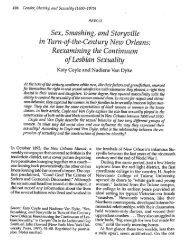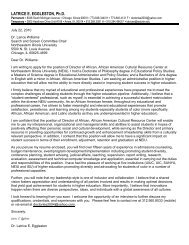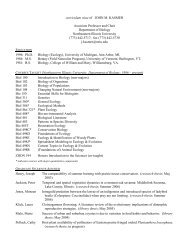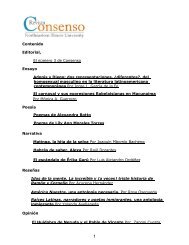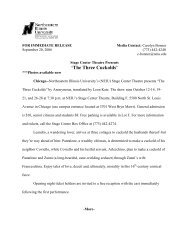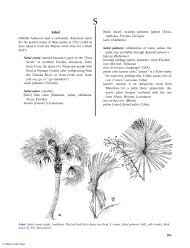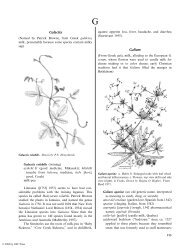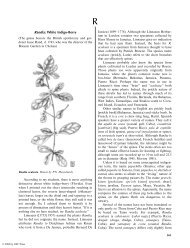Herba Cana - Northeastern Illinois University
Herba Cana - Northeastern Illinois University
Herba Cana - Northeastern Illinois University
Create successful ePaper yourself
Turn your PDF publications into a flip-book with our unique Google optimized e-Paper software.
© 2004 by CRC Press<br />
The Ethnobotany 527<br />
jara. It is not clear if they are comparing the species<br />
with rockrose (Helianthemum, Sonora) because<br />
both have white pubescent leaves, or if they are calling<br />
it an ‘‘arrow’’ (the Spanish from Hebrew khara, to<br />
cast).<br />
The common name cure-for-all is an exaggeration,<br />
but both species are used to treat many problems.<br />
Among the afflictions treated are asthma, bronchitis,<br />
cholera, colds, digestive and eye complaints, fever,<br />
gout, headache, hoarseness, hypertension, menstrual<br />
difficulties, nervousness, neuralgia, night sweats, rheumatism,<br />
sores, spasms, stomach disorders, swelling in<br />
any part of the body, toothache, twitching muscles,<br />
and wheezing. They are also used to treat new mothers<br />
and women in labor (Standley 1920 /1926, Roig 1945,<br />
Martínez 1969, Morton 1981).<br />
Laboratory studies have shown that P. odorata has<br />
antifungal, antimicrobial, antibacterial, and anthelmintic<br />
properties (Dominguez and Zamudio 1972,<br />
López-Abraham et al. 1979, Scholz et al. 1990, 1994).<br />
These traits apparently stem from terpenes. Most of<br />
the known compounds in P. odorata are sesquiterpenes<br />
(Dominguez et al. 1981, Arriaga-Giner et al.<br />
1983, Arriaga and Borges-del-Castillo 1985, Ahmad<br />
et al. 1992a,b, Loayza et al. 1992, Ahmed et al. 1998).<br />
Sesquiterpenes also are among the most reported<br />
chemicals in other species (Ahmad and Fizza 1988a,<br />
b, Ahmad et al. 1989a, 1991, 1992a,b, Ando et al.<br />
1994, Zdero and Bohlmann 1989, Uchiyama et al.<br />
1991, Guilhon and Muller 1996, 1998, Mahmoud<br />
1997, Shimoma et al. 1998). However, monoterpenes,<br />
triterpenes, and triterpenoids are known to have<br />
similar properties (Uchiyama et al. 1991, Kaith 1996,<br />
Pérez-Garcia et al. 1996). Also reported are antiinflammatory<br />
(Srivastava et al. 1990, Sen and Nag<br />
Chaudhuri 1990, 1991, Sen et al. 1993a, Pérez et al.<br />
1995), anti-ulcer (Pal and Chaudhuri 1989, Sen et al.<br />
1993a), hepatoprotective (Sen et al. 1993b), and<br />
trypanocidal (Zani et al. 1994) properties.<br />
Common names indicate an ancient Náhuatl and<br />
Mayan application for women, especially during and<br />
after childbirth, and suggest an original specialized<br />
medicine. With the influx of several European cultures<br />
and confusion with the Old World fleabanes, that<br />
specialization may have given way to a broader<br />
utilization. Indeed, considering the array of uses for<br />
Pluchea, it is easy to see why it became known as a<br />
cure-for-all or guérit-tout. Given the Old World use to<br />
treat poisonous snakebites, it is surprising that people<br />
in the New World did not include that among their<br />
pharmacopoeia. Experimental data for Pluchea actually<br />
indicate that it works for that problem (Alam et al.<br />
1996).<br />
Plumbago: Plumbago or Leadwort<br />
(Latin plumbum, lead, ago from agere, to bear or<br />
resemble)<br />
Plumbago scandens. a. Flowering branch. b. Detail of node.<br />
c. Flowering and subtending bract and bracteole.<br />
d. Stamens, front and side view. e. Gynoecium, with details<br />
of stigma and ovary. Drawn by Bobbi Angell. From Acevedo<br />
2003.<br />
The word ‘‘plumbago’’ appeared in English by<br />
1784 although it has a venerable history in southern<br />
European languages. Most speakers of English call the<br />
plants leadwort. Both names refer to the genus<br />
Plumbago and the family Plumbaginaceae. The history<br />
of the words ‘‘plumbago’’ and ‘‘leadwort’’ is long and<br />
complicated, and sometimes the plant is inseparable<br />
from the metal except by inference.<br />
Dioscorides (fl. A.D. 40 /80) used two Greek words<br />
to designate both a metal and a plant. Pliny (A.D. 23 /<br />
79) Latinized those words as molybdaena and plumbago,<br />
and used both for what is now galena, lead ore.<br />
However, for the plants, Pliny always used plumbago.<br />
In Philemon Holland’s 1601 translation Pliny says,<br />
‘‘There groweth commonly an herbe named in Greeke<br />
Molybdaena, that is to say in Latin, Plumbago, euen<br />
vpon euery corne land.’’ Matthioli’s Commentary on<br />
Dioscorides was translated into French in 1572, and<br />
subsequently most French, Italian, and German<br />
speakers reapplied ‘‘plumbago’’ to the metal. Linnaeus





